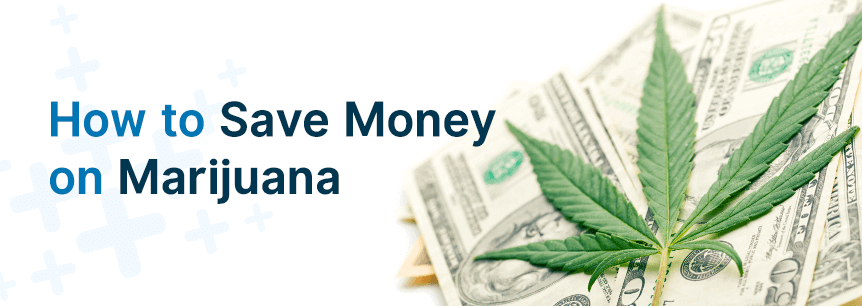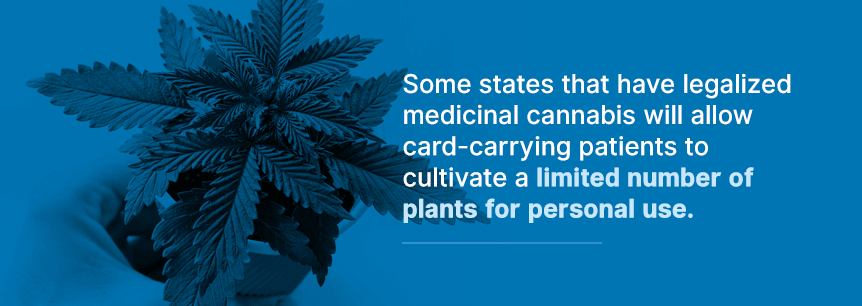
If you need medical marijuana, you will likely find the costs add up over time. Like other medicines you take, you have ways to save money on marijuana. While insurance does not cover this treatment because it is classified as a schedule I drug and lacks FDA approval, you can still incorporate your medical marijuana into your budget. Money-saving methods make it easier to afford cannabis. Here are some sensible ways to make medicinal weed affordable for almost any budget.
If you need cannabis to treat a medical condition, you should get a medical marijuana card. This card, which is required in most states that have legalized medical cannabis, allows you to purchase weed from a dispensary. Without it, if law enforcement catches you with marijuana, you could pay fines or spend a brief time in jail. Though a medical marijuana card has an initial fee — for instance, Pennsylvania charges $50 — it will save you time and hassle in the future.
Aside from making your purchases legal, if you live in a state that also allows for recreational marijuana, you could save money with a medical card over purchasing your weed retail. With retail purchases, you have higher prices and taxes on your cannabis purchases. In Colorado, for instance, taxes on medicinal marijuana are 25 percent lower than retail cannabis.
The cost to purchase the medical marijuana card means you will need to buy a set amount of pot in each state with your card before you offset the card’s fee. To ensure you save money, consider how much marijuana you need to purchase annually to see if you buy enough to see savings in your state. Here are some examples of the amount of cannabis you need to purchase for medicinal purposes to save money over the cost of buying it retail:
You already know that you can save money on household goods like toilet tissue and paper towels by buying in bulk. The same is true for cannabis. Some dispensaries offer bulk discounts when you purchase. Though you will pay more, your cost per ounce will be lower. Choose this option if you have a chronic condition that requires regular or frequent medical marijuana use. To ensure savings, ask your dispensary if you can get discounts for large-volume purchases.
Check your state’s laws about growing plants in your home. Some states that have legalized medicinal cannabis will allow card-carrying patients to cultivate a limited number of plants for personal use. If you have concerns, ask your marijuana-certified doctor about the legal requirements in your state for growing medical marijuana.

Some states require you to live a specific distance from a dispensary before you can cultivate your plants. Arizona has such a law that only allows you to grow up to 12 plants if you live more than 25 miles from a dispensary. Other states, such as West Virginia, do not allow home cultivation of marijuana for any purpose.
Don’t forget the cost to cultivate the plants. The money required to water, feed and provide light and soil for your plants should be factors in whether growing your own will save you money.
When you visit the dispensary, see about negotiating. Ask about free products if you agree to review the business on your social media or refer others to the place. Some dispensaries offer a referral program. Through such a program, you get discounts or free samples when you recommend the dispensary to others.
Get to know the workers at the dispensary, too. When you do, kindly ask if they can provide you with free samples. If you get any extras, though, don’t forget to tip well. Tipping ensures the workers know their actions are appreciated, and you may increase your chances of freebies in the future.
If you have the luxury of living close enough to several dispensaries, shop around for the lowest prices on the cannabis products you need. You can either visit in person or try calling if you don’t want to spend the time driving or the money on gas. Whichever method you choose, talking to each dispensary’s workers can give you the chance to compare prices on marijuana as well as possible discounts on cannabis products. If you get in touch by phone, you will also have the opportunity to get questions answered about your future purchases before you arrive at the dispensary, saving you time on your errand.
Not all dispensaries accept coupons, but if the one you visit does, do not forget to bring it with you. Some facilities may take deals from the internet or discount codes found on their website. If you base your dispensary destination on the cost of cannabis you can get there with a coupon, call ahead to verify the location will offer the discount. Some coupons found online could be fakes. Calling will ensure you will not get scammed when trying to save money at the dispensary.
If your dispensary does not accept coupons, ask about other discounts you may take advantage of. Some deals may include those for frequent shoppers, seniors, first-time buyers or military members. Also, ask the workers at the facility if the dispensary has sales going on or if it offers regular seasonal deals. Holiday sales occur at other types of retailers. Depending on where you shop, your dispensary may do the same.
Like many places, your dispensary may offer discounts for joining its social media sites or email list. Emailed newsletters can alert you of upcoming sales or provide you with deals and other ways to save money. Ask if your dispensary offers these ways to save money.

Instead of purchasing potentially expensive edibles from the dispensary, you can also try making your own — anything from desserts and snacks to chewables, capsules, and syrups. If you’d rather drink your cannabis, you can also try incorporating it into beverages, such as sodas, smoothies, juices and more.
One simple way to include medical marijuana into various edible items is to cook with marijuana flour or cannabutter —butter that’s been infused with cannabis. The trick when making cannabutter, though, is to ensure you first activate the THC in a process called decarboxylation. The THC also can’t get too hot, either. Otherwise, it will burn and will no longer provide the taste or the nutrients you’re going for.
Use cannabutter on toast or add it to a salad dressing. You could even try making cannabis-infused granola. The possibilities for making your own edibles are endless — you’ll also know exactly what’s in your edibles and save money as well.
Talk to your doctor before changing the dose of any medicine you take, including marijuana. If your doctor allows you to do so, take the lowest dose of marijuana necessary to get the desired result. Using less will stretch the time the cannabis you purchased last longer. If you are not sure of the dose to take, talk to your doctor.
Inhaled marijuana hits your body quickly, producing fast results, but ingested cannabis will not have the same effect. You might not see relief of your symptoms for up to a few hours — but the marijuana’s effects will usually last longer than other ingestion methods. If you’re not anticipating this, you could accidentally use more marijuana than you need to control your symptoms. To save money, allow your cannabis enough time to become effective before ingesting any more.
Some things you do can help you lower the amount of marijuana you need. If you engage in exercise, you can make your grass more effective. Physical activity encourages the body to release endocannabinoids, which act similar to THC in the body. Exercise helps improve your physical and mental well-being, so you may need less pot to get relief from your symptoms. Carefully add activity to your lifestyle, and always ask your doctor if your body is ready to start working out.

If you consume edibles or ingest cannabis in any way, what you eat with the dose makes a difference. High-fat products like butter and oil are frequently infused with marijuana to produce edibles because the active compounds are fat-soluble. Ingesting cannabis products with a low-fat meal or on an empty stomach reduces the amount of the active ingredients your body uses. You will waste much of the marijuana taking it this way. Take your cannabis with some nut butter, avocado, fish or another high-fat food to increase absorption.
Taking in healthy, omega-3 fatty acids can also improve your body’s use of its endocannabinoid system. In research on mice, those that ate diets high in polyunsaturated fats had fewer antagonists to endocannabinoid receptors. The study’s results showed a link to high polyunsaturated fats and higher levels of endocannabinoid enzymes and cannabinoid receptors. With more cannabinoid receptors available, your medical marijuana has more binding sites in the body to go to, possibly making it more effective.
Another way to improve your body’s use of cannabis is timing the doses to get the best results. If you use medical marijuana to help you with sleep, taking the treatment closer to bed may make you sleep better than using it earlier in the day. For all-day relief, take small doses at regular intervals throughout the day. You will get a more consistent amount in your bloodstream for steady relief. While small, stable dosing of marijuana into your body can help keep your symptoms at bay, you may also benefit from taking a break.
One thing to keep in mind is that developing a certain tolerance of marijuana is possible, and withdrawal symptoms could develop if you suddenly stop using cannabis. This rarely affects patients who use lower doses, however, and often a short break from the medication can remedy that tolerance. Always talk to your doctor about taking a medicine break even for a short while, though. As with all medical concerns, always follow your doctor’s advice.
Should your doctor recommend marijuana, they have decided it to be a good option for you. Don’t stop taking any medications without consulting with your doctor, but to save money on medical marijuana, you might consider supplementing it with another treatment to reduce your use.
If you are using medicinal marijuana, you have probably already tried numerous other solutions to have them prove inadequate. But combining some mildly effective treatments with your cannabis could help you use less of both. Discuss any medication combinations with your doctor to avoid serious complications or drug interactions. Don’t forget that marijuana is still medicine and can interact with other drugs you take.

While many states offer both recreational and medicinal marijuana, more states only allow the purchase of medical cannabis. Due to the prohibitive cost of marijuana and its prohibited sales for recreational use in many locations, you will need to protect your weed from people who may want to use it recreationally.
As with all medicines, never share your cannabis with other people. You will waste money, have less for yourself and possibly break the law. Protect your marijuana the same as you would other prescription drugs. Consider getting a prescription medicine lock box to protect your purchase and save you money.

To save money on cannabis, you need a dispensary close to your home. You don’t want to waste gas in your efforts to save money on your treatment. Use this simple resource to find a dispensary near you. If you need a marijuana doctor, you can also locate one in your state. Thanks to the Internet, you don’t have to wonder where to go after getting your marijuana recommendation. The only thing left for you to do is choose which method you will use to save money on your medicine.
Find A Doctor Find A Dispensary
No Information on MarijuanaDoctors.Com should be used to diagnose, treat, prevent or cure any disease or condition. You can view our Full Disclaimer here.